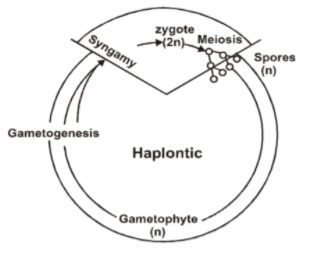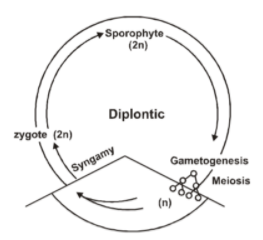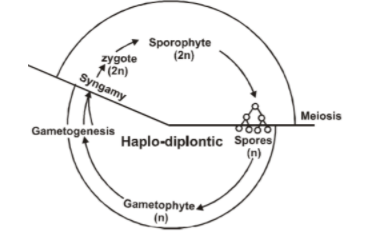Question
Question: Zygotic meiosis is characteristic of a. Prokaryotes b. Thallophyta c. Pteridophyta d. Sperma...
Zygotic meiosis is characteristic of
a. Prokaryotes
b. Thallophyta
c. Pteridophyta
d. Spermatophyta
Solution
In phanerogams, sporic meiosis is present, in which sporophyte undergoes meiosis to form haploid spores.
The zygotic meiosis is found in the haplontic life cycle, in which meiosis occurs in zygote.
The gametic meiosis occurs in some fungi, in which meiosis occurs in the cells of diploid organisms to form haploid gametes.
Complete answer: In order to solve this question, we need to know about the three types of life cycle of plants.
In plants, three types of life cycles are present- Haplontic, Diplontic and Diplohaplontic.
(a) Haplontic: In this type of life cycle, the dominant phase is haploid. The diploid phase is represented only by zygote. It shows zygotic meiosis in which meiosis occurs in zygote just after karyogamy. As a result, a diploid cell produces haploid cells. These cells divide mitotically to produce more haploid cells. In this type of life cycle, zygote is the only cell which is diploid in nature and mitosis occurs in haploid cells. It is found in Chlamydomonas, Spirogyra, Ulothrix, Dinoflagellates and most of the fungi.

(b) Diplontic: In this type of life cycle, the dominant phase is diploid. It shows gametic meiosis in which meiosis occurs in the cells of diploid individuals to form haploid gametes. These haploid gametes fuse to form diploid zygote. The diploid cells undergo mitosis to form diploid individuals. In this type of life cycle, gamete is the only cell which is haploid in nature and mitosis occurs in diploid cells. It is found in Cladophora, Acetabularia, animals and some fungi.

(c) Diplohaplontic: In this type of life cycle, both haploid phase (gametophyte) and diploid phase (sporophyte) are present. It shows sporic meiosis. The haploid gametophytes divide and form haploid gametes. These gametes fuse to form diploid zygote, which on germination gives rise to diploid sporophyte. The sporophyte undergoes meiosis and forms haploid meiospores, which on germination gives rise to haploid gametophyte. It is found in Ulva, some fungus, pteridophytes and land plants.

So, the correct answer is option B, Thallophyta.
Note: The members of green algae show zygotic, gametic and sporic meiosis.
In the life cycle of sexually reproducing organisms, alternating haploid and diploid stages are present. They show alternation of generation.
